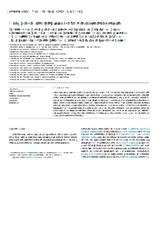Mostrar el registro sencillo del ítem
A new method for determining the sources of airborne particles
| dc.contributor.author | Oteros, José | |
| dc.contributor.author | García-Mozo, H. | |
| dc.contributor.author | Alcázar, Purificación | |
| dc.contributor.author | Belmonge, Jordina | |
| dc.contributor.author | Bermejo, Daria | |
| dc.contributor.author | Boi, Marzia | |
| dc.contributor.author | Cariñanos, P. | |
| dc.contributor.author | Díaz de la Guardia, C. | |
| dc.contributor.author | Fernández González, Delia | |
| dc.contributor.author | González-Minero, Francisco | |
| dc.contributor.author | Gutiérrez Bustillo, Adela M. | |
| dc.contributor.author | Moreno Grau, Stella | |
| dc.contributor.author | Pérez-Badía, Rosa | |
| dc.contributor.author | Rodríguez-Rajo, F.J. | |
| dc.contributor.author | Ruiz Valenzuela, Luis | |
| dc.contributor.author | Suárez Pérez, Julia | |
| dc.contributor.author | Trigo, M. Mar del | |
| dc.contributor.author | Domínguez Vilches, E. | |
| dc.contributor.author | Galán, Carmen | |
| dc.date.accessioned | 2024-02-08T20:13:05Z | |
| dc.date.available | 2024-02-08T20:13:05Z | |
| dc.date.issued | 2015 | |
| dc.identifier.issn | 0301-4797 | |
| dc.identifier.uri | http://hdl.handle.net/10396/27331 | |
| dc.description.abstract | Air quality is a major issue for humans owing to the fact that the content of particles in the atmosphere has multiple implications for life quality, ecosystem dynamics and environment. Scientists are therefore particularly interested in discovering the origin of airborne particles. A new method has been developed to model the relationship between the emission surface and the total amount of airborne particles at a given distance, employing olive pollen and olive groves as examples. A third-degree polynomial relationship between the air particles at a particular point and the distance from the source was observed, signifying that the nearest area to a point is not that which is most correlated with its air features. This work allows the origin of airborne particles to be discovered and could be implemented in different disciplines related to atmospheric aerosol, thus providing a new approach with which to discover the dynamics of airborne particles. | es_ES |
| dc.format.mimetype | application/pdf | es_ES |
| dc.language.iso | eng | es_ES |
| dc.publisher | Springer | es_ES |
| dc.rights | https://creativecommons.org/licenses/by-nc-nd/4.0/ | es_ES |
| dc.source | Oteros, J., Garcı́a-Mozo, H., Alcázar, P., Belmonte, J., Bermejo, D., Boi, M., Cariñanos, P., De la Guardia, C. D., Fernández-Gonzalez, D., González-Minero, F. J., Gutiérrez-Bustillo, A. M., Moreno‐Grau, S., Pérez-Badía, R., Rodríguez-Rajo, F. J., Valenzuela, L. R., Suárez‐Pérez, J. A., Trigo, M., Domínguez-Vilches, E., & Galán, C. (2015). A new method for determining the sources of airborne particles. Journal Of Environmental Management, 155, 212-218. https://doi.org/10.1016/j.jenvman.2015.03.037 | es_ES |
| dc.subject | Airborne particles | es_ES |
| dc.subject | Pollen | es_ES |
| dc.subject | Environmental monitoring | es_ES |
| dc.subject | Geostatistic | es_ES |
| dc.subject | Dispersion | es_ES |
| dc.subject | Environment | es_ES |
| dc.title | A new method for determining the sources of airborne particles | es_ES |
| dc.type | info:eu-repo/semantics/article | es_ES |
| dc.relation.publisherversion | https://doi.org/10.1016/j.jenvman.2015.03.037 | es_ES |
| dc.relation.projectID | Junta de Andalucía. P10-RNM-5958 | es_ES |
| dc.relation.projectID | Gobierno de España. CGL2011-24146 | es_ES |
| dc.rights.accessRights | info:eu-repo/semantics/openAccess | es_ES |

